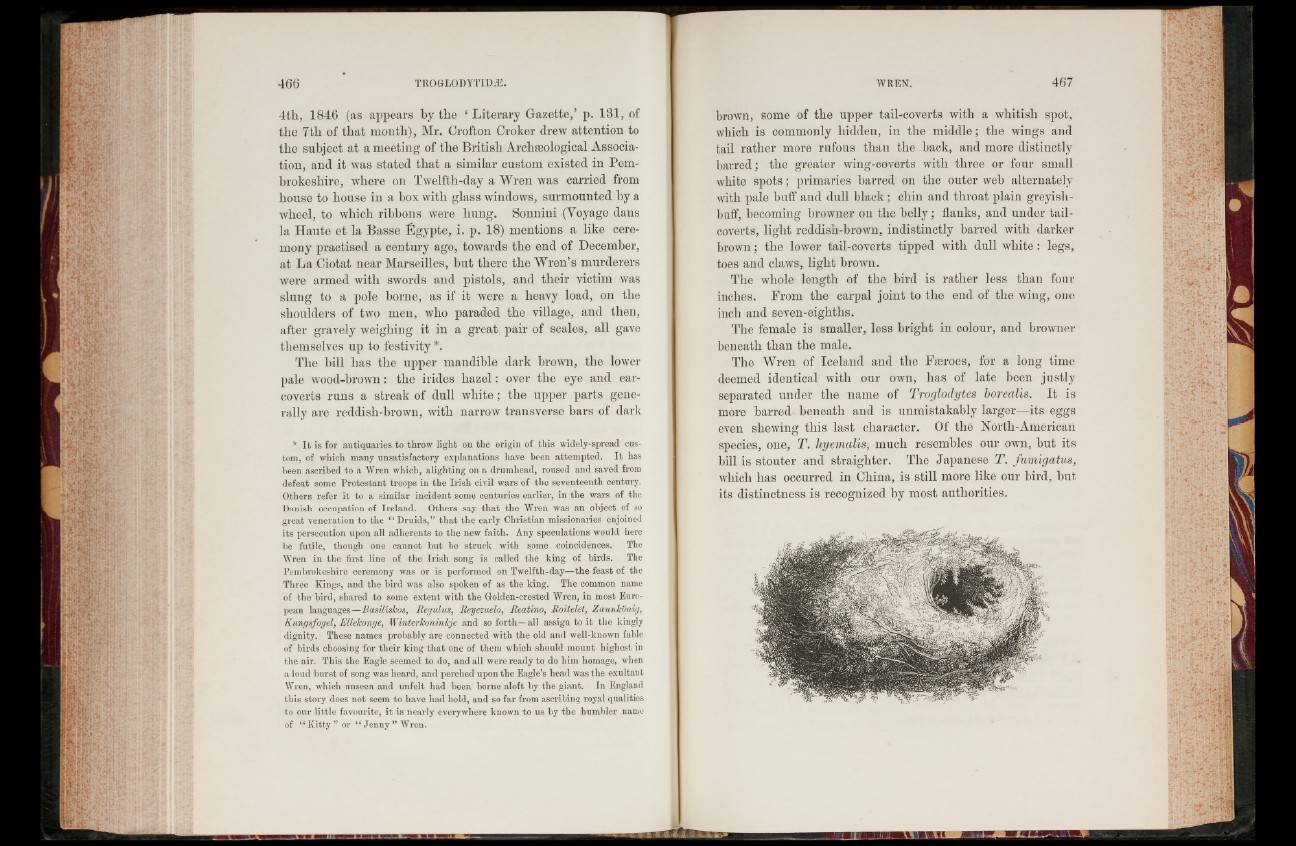
4th, 1846 (as appears by the ‘ Literary Gazette,’ p. 131, of
the 7tli of that month), Mr. Crofton Croker drew attention to
the subject at a meeting of the British Archaeological Association,
and it was stated that a similar custom existed in Pembrokeshire,
where on Twelfth-day a Wren was carried from
house to house in a box with glass windows, surmounted by a
wheel, to which ribbons were hung. Sonnini (Voyage dans
la Haute et la Basse Égypte, i. p. 18) mentions a like ceremony
practised a century ago, towards the end of December,
at La Ciotat near Marseilles, but there the Wren’s murderers
were armed with swords and pistols, and their victim was
slung to a pole borne, as if it were a heavy load, on the
shoulders of two men, who paraded the village, and then,
after gravely weighing it in a great pair of scales, all gave
themselves up to festivity*.
The hill lias the upper mandible dark brown, the lower
pale wood-brown: the irides hazel: over the eye and ear-
coverts runs a streak of dull white ; the upper parts generally
are reddish-brown, with narrow transverse bars of dark
* I t is for antiquaries to throw light on the origin of this widely-spread custom,
of which many unsatisfactory explanations have been attempted. It has
been ascribed to a Wren which, alighting on a drumhead, roused and saved from
defeat some Protestant troops in the Irish civil wars of the seventeenth century.
Others refer it to a similar incident some centuries earlier, in the wars of the
Danish occupation of Ireland. Others say that the Wren was an object of so
great veneration to the “ Druids,” that the early Christian missionaries enjoined
its persecution upon all adherents to the new faith. Any speculations would here
be futile, though one cannot but be struck with some coincidences. The
Wren in the first line of the Irish song is called the king of birds. The
Pembrokeshire ceremony was or is performed on Twelfth-day—the feast of the
Three Kings, and the bird was also spoken of as the king. The common name
of the bird, shared to some extent with the Gfolden-crested Wren, in most European
languages—Basiliskos, Regulus, Reyezuelo, Reatino, Roitelet, Zaunlconig,
Kuncjsfogel, Ellekonye, Winterhoninleje and so forth—all assign to it the kingly
dignity. These names probably are connected with the old and well-known fable
of birds choosing for their king that one of them which shovdd mount highest in
the air. This the Eagle seemed to do, and all were ready to do him homage, when
a loud burst of song was heard, and perched upon the Eagle’s head was the exultant
Wren, which unseen and unfelt had been borne aloft by the giant. In England
this story does not seem to have had hold, and so far from ascribing royal qualities
to our little favourite, it is nearly everywhere known to us by the humbler name
of “ Kitty ” or “ Jenny ” Wren.
brown, some of the upper tail-coverts with a whitish spot,
which is commonly hidden, in the middle; the wings and
tail rather more rufous than the hack, and more distinctly
barred; the greater wing-coverts with three or four small
white spots; primaries barred on the outer web alternately
with pale buff and dull black; chin and throat plain greyish-
buff, becoming browner on the belly; flanks, and under tail-
coverts, light reddish-brown, indistinctly barred with darker
brown; the lower tail-coverts tipped with dull white: legs,
toes and claws, light brown.
The whole length of the bird is rather less than four
inches. From the carpal joint to the end of the wing, one
inch and seven-eightlis.
The female is smaller, less bright in colour, and browner
beneath than the male.
The Wren of Iceland and the Fasroes, for a long time
deemed identical with our own, has of late been justly
separated under the name of Troglodytes borealis. I t is
more barred beneath and is unmistakably larger—its eggs
even shewing this last character. Of the North-American
species, one, T. hyemalis, much resembles our own, but its
bill is stouter and straighter. The Japanese T. fumigatus,
which has occurred in China, is still more like our bird, but
its distinctness is recognized by most authorities.